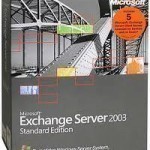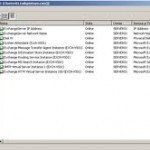Understanding Exchange Server 2003 Administrative Groups With Exchange Server 2003, an administrative group is a collection of Exchange Server 2003 objects. Here, Exchange Server 2003 objects are grouped for the intent of delegating permissions and managing permissions. An administrative group can be created to support different administrative models: Centralized. Decentralized. Mixed administrative model. The Exchange Server 2003 objects that can exist in an administrative group are listed here: System policy objects. Server objects. Public folder tree objects. Routing group objects. When you install an Exchange Server 2003 organization, the new Read More
Restoring Exchange Server 2003
Documenting your Exchange Server 2003 Environment To successfully restore or recover any aspect of your Exchange Server 2003 environment, it is important that you document the following: The Exchange Server 2003 environment. The backup process. The recovery process. A well documented or complete Exchange Server 2003 environment document should include the following information: The Exchange server name. The Windows version and service pack running on your servers. The Exchange version and service pack running on your servers. The Exchange organization name. Site names. Database names and sizes. Database locations. Storage Read More
Backing Up the Exchange Server 2003 Environment
Understanding the Data Types to Back Up There are a number of reasons why Exchange data should be backed up: To provide protection in the event of a system crash. To be able to recover corrupt databases. To be able to recover the following: Mailboxes. Folders. Messages. To restore Exchange in a lab for testing. The different types of data that should be backed up can be classified as follows: Static data: Consists of data that hardly ever changes: Windows Server 2003 operating system software. Software updates and service packs. Read More
Installing Exchange Server 2003 Clusters
Microsoft Cluster Service Overview Microsoft Clustering Server (MSCS), initially launched in the Windows NT Server Enterprise Edition, enabled organizations to increase server availability for mission critical resources by grouping multiple physical servers into a cluster. Servers in the cluster are referred to as nodes, while services and applications are referred to as resources. A cluster can be defined as the grouping of two or multiple physical servers that are portrayed as, and operate as one network server. These servers provide redundancy to the enterprise network by resuming operations of a Read More
Managing Exchange Server Connectivity Across Firewalls

Using Firewalls To Prevent Unauthorized Access The method, by which you can physically secure the network, is through the usage of firewalls. While firewalls provide some level of physical security, you should bear in mind that firewalls are just barriers which make it difficult for intruders to attack the network. Firewalls are categorized as follows: Network firewalls: These firewalls monitor traffic entering and exiting the network, in an attempt to protect the perimeter network. Software based Microsoft Internet Security and Acceleration (ISA) Server and the hardware based Nortel Networks Alteon Read More
Exchange Server 2003 Maintenance and Management Activities
Managing the Different Server Roles The different roles that can be configured for Exchange Server 2003 are listed here: Mailbox Store server (back-end server): The mailbox store server is mainly responsible for the following functions: Storing of messages of mail-enabled users. Storing attachments. Storing files and folders. Managing the mailbox store server includes configurations and tasks performed through Exchange System Manager and standard server maintenance tasks. Public Folder server: This server stores messages and message posting in a hierarchical manner. If your system has multiple public folders, then you would Read More
Exchange Server 2003 Virtual Servers

Exchange Server 2003 Virtual Servers Overview Simple Mail Transfer Protocol (SMTP) Virtual Servers Simple Mail Transfer Protocol (SMTP) is an industry standard protocol used for the Internet. SMTP controls the communication of email messages and the message formats between messaging hosts. SMTP Service Extensions (ESMTP) is an extension of SMTP that enables users to request delivery status notifications on outgoing messages. It also makes it possible for a message size to be defined for inbound ESMTP connections. SMTP and ESMTP require the TCP/IP protocol as the transport means. The SMTP/ESMTP Read More
Configuring and Maintaining Exchange Server 2003 Virtual Servers

Configuring Exchange Virtual Server Settings Exchange System Manager can be used to create new Exchange Server 2003 virtual servers. A Protocols container exists below each server object. Expand the nodes in the console tree of Exchange System Manager to view this. Each Internet protocol is signified by a different container. Any related virtual protocol servers are bundled together. To add a new virtual server, right click on the particular protocol container, select New, and then select the associated Virtual Server command. A unique IP address and name has to be Read More
Planning an Exchange Server 2003 Infrastructure
Understanding the Different Combinations of Exchange and Windows Server The different supported combinations of Exchange and Windows Server are listed here: Exchange Server 5.5 is supported on the following Windows versions: Windows NT 4 Server. Windows 2000 Server. Can only replicate data to Active Directory and from Active Directory through the Active Directory Connector (ADC). Exchange 2000 Server is supported on the following Windows versions: Windows 2000 Server with Service Pack 1 or higher. Reliant on Active Directory. Can be installed on a member server or on domain controller. Exchange Read More
Creating and Managing Public Folders
Public Folder Overview In Exchange Server 2003, public folders can be used to share information between a group of users. In smaller organizations where only one Exchange server is typically installed, one public folder instance can exist. Where there are multiple Exchange servers and you need to provide fast access to public folder information, then you would probably have to create an additional public folder instance. Public folders can be created through: Outlook 2003 Outlook XP Outlook 2000 Exchange System Manager Windows Explorer Internet clients Web browsers The public folder Read More


Share on: